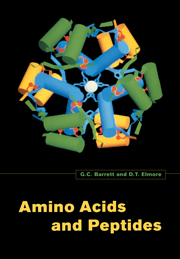Book contents
- Frontmatter
- Contents
- Foreword
- 1 Introduction
- 2 Conformations of amino acids and peptides
- 3 Physicohemical properties of amino acids and peptides
- 4 Reactions and analytical methods for amino acids and peptides
- 5 Determination of the primary structure of peptides and proteins
- 6 Synthesis of amino acids
- 7 Methods for the synthesis of peptides
- 8 Biological roles of amino acids and peptides
- 9 Some aspects of amino-acid and peptide drug design
- Subject index
8 - Biological roles of amino acids and peptides
Published online by Cambridge University Press: 05 June 2012
- Frontmatter
- Contents
- Foreword
- 1 Introduction
- 2 Conformations of amino acids and peptides
- 3 Physicohemical properties of amino acids and peptides
- 4 Reactions and analytical methods for amino acids and peptides
- 5 Determination of the primary structure of peptides and proteins
- 6 Synthesis of amino acids
- 7 Methods for the synthesis of peptides
- 8 Biological roles of amino acids and peptides
- 9 Some aspects of amino-acid and peptide drug design
- Subject index
Summary
Introduction
Amino acids fulfil three broad classes of function in biology. They serve as building blocks in prokaryotes and plant and animal eukaryotes for the synthesis of peptides and proteins. Most peptides derive from the processing of proteins, but some such as glutathione, folate and peptide antibiotics are biosynthesised by specific non-ribosomal routes (see Chapter 9). In contrast, particular amino acids, especially glycine, are required in the synthesis of a wide variety of small molecules, including alkaloids, purine and pyrimidine nucleotides, porphyrins, creatine and phospho-creatine. The second role of amino acids is to act as intermediates in incorporating or disposing of small molecules. For example, arginine is involved in various reaction sequences in the disposal of unwanted nitrogen as urea and the production of perhaps the most unexpected biomolecule, nitric oxide. Again, methionine makes its S-methyl group available for methylation reactions via the intermediate S-adenosylmethionine. Finally, some important biomolecules are derived by the metabolism of amino acids. Enzymic decarboxylation of some of the coded amino acids or of a hydroxylated derivative gives rise to important cellular messengers and hormones. Alternatively, an amino acid and an α-keto acid can undergo a trans-amination reaction and, since several a-keto acids are important metabolic intermediates, this reaction offers a simple route to some of the inessential amino acids. The amino group can also be removed oxidatively from an amino acid, giving rise to an α-keto acid. Some amino acids such as histidine and tryptophan undergo unique ring-opening reactions that lead, through rather complex pathways, to glu-tamic acid and alanine, respectively.
- Type
- Chapter
- Information
- Amino Acids and Peptides , pp. 174 - 199Publisher: Cambridge University PressPrint publication year: 1998
- 2
- Cited by



